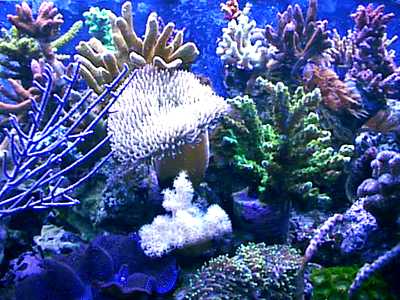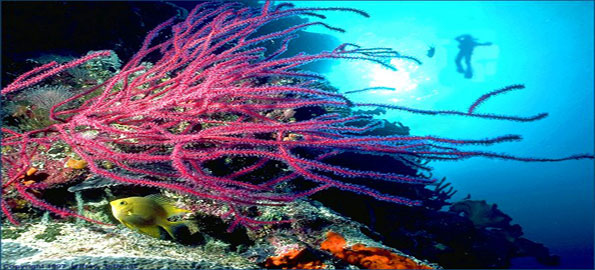The mention of coral reefs generally brings to mind warm climates, colorful fish and clear waters. However, the reef itself is actually a component of a larger ecosystem. The coral community is really a system that includes a collection of biological communities, representing one of the most diverse ecosystems in the world. For this reason, coral reefs often are referred to as the "rainforests of the oceans.
A coral reef off the island of La Dique
What are coral reefs?
Corals are in fact are tiny animals which belong to the group cnidaria (the "c" is silent). Other cnidarians include hydras, jellyfish, and sea anemones. Corals are sessile animals, meaning they are not mobile but stay fixed in one place. They feed by reaching out with tentacles to catch prey such as small fish and planktonic animals.
Coral reefs provide habitats for a large variety of organisms. These organisms rely on corals as a source of food and shelter. Besides the corals themselves and their symbiotic algae, other creatures that call coral reefs home include various sponges; molluscs such as sea slugs, nudibranchs, oysters, and clams; crustaceans like crabs and shrimp; many kinds of sea worms; echinoderms like star fish and sea urchins; other cnidarians such as jellyfish and sea anemones; various types of fungi; sea turtles; and many species of fish.
Coral Reefs are home to many species of ocean life
The tropical rain forests of the ocean
The tropical rain forests of the ocean
How do coral reefs forms?
Coral reefs begin to form when free-swimming coral larvae attach to submerged rocks or other hard surfaces along the edges of islands or continents. As the corals grow and expand, reefs take on one of three major characteristic structures —fringing, barrier or atoll. Fringing reefs, which are the most common, project seaward directly from the shore, forming borders along the shoreline and surrounding islands. Barrier reefs also border shorelines, but at a greater distance. They are separated from their adjacent land mass by a lagoon of open, often deep water. If a fringing reef forms around a volcanic island that subsides completely below sea level while the coral continues to grow upward, an atoll forms. Atolls are usually circular or oval, with a central lagoon. Parts of the reef platform may emerge as one or more islands, and gaps in the reef provide access to the central lagoon.
A coral reef formation off Mahe
Threats to Coral Reefs
Human Contact: Touching Reefs, even slightly, can harm them. Boats and dropped anchors can cause severe damage to these fragile ecosystems. Frequent human contact kills the reefs over time.
Runoff Water: Silt from eroded soil in runoff water can block sunlight. Without sunlight, photosynthesis does not occur and reefs gradually die.
Sewage: Untreated or improperly treated sewage promotes the growth of algae, which harms coral reefs.
Cyanide Fishing: Some fishermen stun fish by squirting cyanide, a very toxic poison, into reef areas where fish seek refuge. The poison does not kill, but disorients the fish in the coral where they hide. The fisherman then rip apart the reefs with crowbars to capture the fish. In addition, cyanide kills coral polyps and the symbiotic algae and other small organisms necessary for healthy reefs. Cyanide fishing is common in the South Pacific and Southeast Asia.
Fertilizers and Pollution: Fertilizer runoff, pesticides and other chemicals can poison reefs.
Blast Fishing: Shockwaves from blast fishing can destroy coral reefs.
Blast fishing can destroy coral reefs
Coral Reef Conservation in the Seychelles
Fortunately the Seychelles government realises the importance of coral reefs not only to tourism and the economic livelihood for locals, but also for the overall ecosystem of their waters. Many conservation programmes are in place, as well as strictly governed laws concerning the coral reefs. So it is certainly safe to say that the coral reefs of Seychelles are in good hands, and as such we can enjoy their beauty for many years to come!
Coral Reef Conservation
Some more Seychelles Coral Reefs...







Seychelles-Tourism-Board?$615x346$)



No comments:
Post a Comment